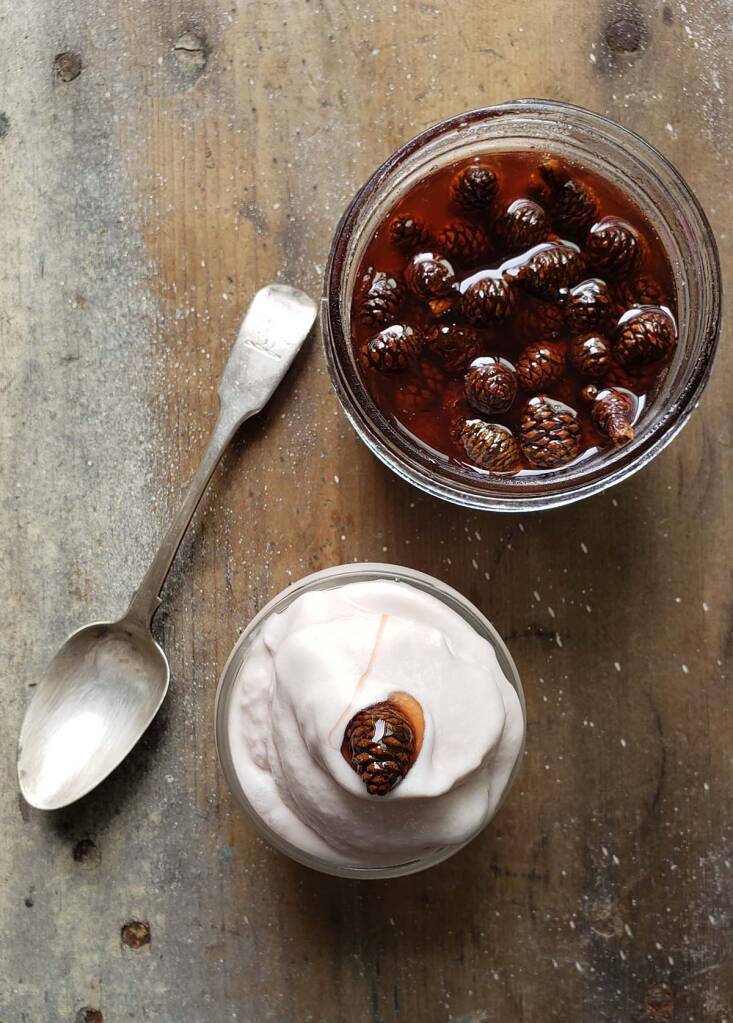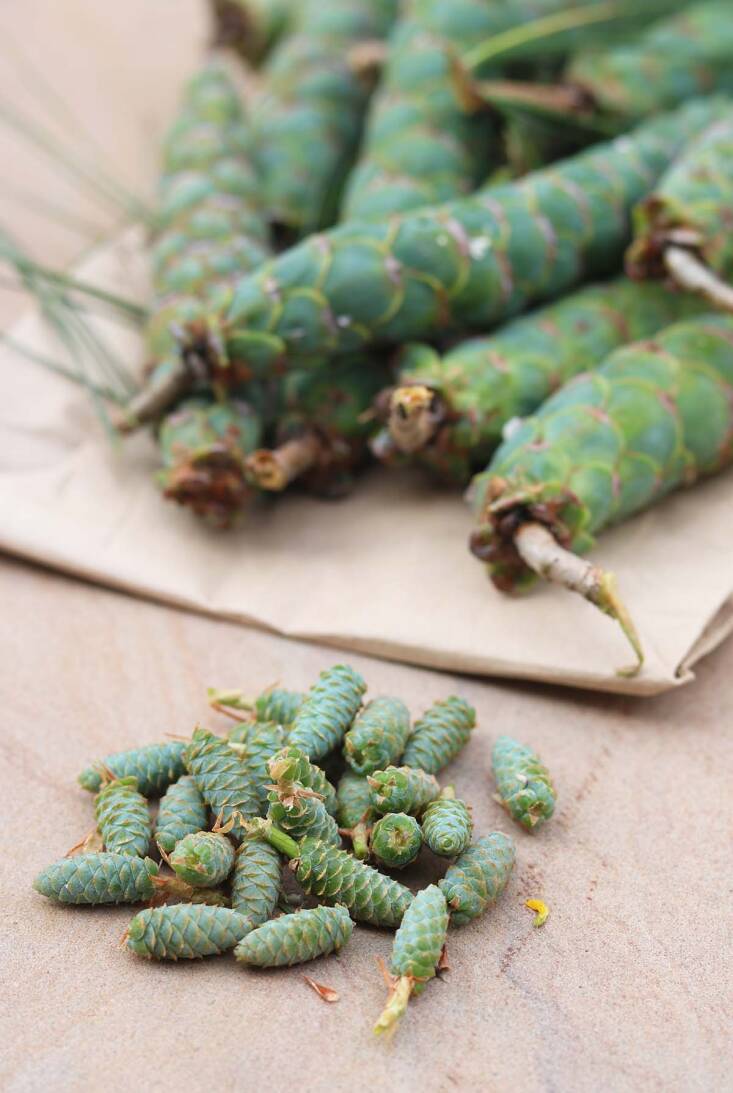Pine cone jam. A tongue-scraping oxymoron or a soothing and familiar treat? That depends where you come from.
In Eastern Europe and Russia sweet pine cone preserves are sold in stores and by vendors at outdoor markets, the petite baby cones nestled in jars of dark syrup. In Italy that syrup (created by cooking immature pine cones) is called mugolio, after Pinus mugo, the tree whose cones are typically used, there. Along the Eastern Mediterranean that syrup may be sold as pine honey (pine produce no nectar, but aphids feeding on them can produce honeydew that bees collect).
But I knew none of that in May of 2019, standing on a dune at Fort Tilden, Queens, where I was collecting the pine pollen that I use in my wild foods kitchen. I did know that I wanted to experiment with the bud-like cones I could see forming at the tips of the same branches. Their resinously fresh scent was irresistible. I collected a tender bagful and carried them home.
It was the beginning of a delicious—and sticky—adventure.
Photography by Marie Viljoen


I had worked with young pine cones before, making a fermented syrup from them. It is compelling. But could the cones themselves be made to taste good?

Looking for inspiration online I chanced upon a recipe in The Georgian Journal for “Georgian pine cone jam”. It was described as a remedy for coughs: “This jam is real medicine!” wrote the article’s anonymous author. I consulted my Georgian cookbooks for something similar. Nothing. The ever-inspiring Classic Russian Cooking by Elena Molokhovets, published in the nineteenth century, was silent on the subject. Disappointed. Aside from the jam, the Internet offered just the sound of crickets.

The Georgian recipe was guide-enough and my first pot of baby pine cones was soon on the stove. The result was surprising and exciting. Jam from pine cones! I experimented with subsequent batches, adding a blanching-step to the process.
The flavor of the jammed cones is tartly sweet and resinous, their texture like chewy candy. The “honey”—their cooking medium—is rich, like molasses licked from a spoon in a pine forest. It is also a very versatile ingredient.

“Let the next foraging craze begin…” I wrote gleefully on Instagram that May. And it did. The Internet vacuum has been filled at a speed only social media can achieve, with a surge of forager’s pine cone jam recipes and tutorials.
About a year ago, in the aisles of Gala Apple International, a supermarket in the Kensington neighborhood of Brooklyn that caters to Eastern Europeans, Russians, and immigrants from the Caucasus, I discovered jars of pine cone varenye and Turkish pine honey, beside jars of other entrancing preserves like sea buckthorn, viburnum, and Cornelian cherries. They had been there all the time. Full circle, I thought. And bought some.

Pine cone honey is good drizzled sparingly on toast. It’s a conversation-starter on a cheese plate. And it does make a very soothing tea if you have a sore throat.
I use the candied cones to top savory appetizers, and it adds depth to the roasted, puréed vegetable pâtés (carrot and beet, especially) that I use as spreads or tart fillings.

In pastries, the pine cones flavor and adorn thumbprint cookies and hand pies, and I hide a single cone inside featherlight madeleines. The honey is wonderful added to roasting root vegetables, and to the pan-sauce for duck legs, and thick-cut pork chops.

Vodka is transformed by the addition of the jam: stir them together and leave to infuse for a week. The honey dissolved into sipping vinegar and topped with seltzer is a refreshing shrub.

Collect baby cones from early spring to early summer. They should be sappy and green when you dig a fingernail into them. Their size and color may be reddish, tan, or green, depending on their age and the species. During the year you may find a range of these female cones on a single tree. Tiny cones are best for jam-making, but the larger green cones can be used for pine honey.

Cones from any pine species will make good jam. So will fir and spruce.
Wherever you are, you may find a friendly tree willing to spare some cones for your pleasure, and medicine.

Pine Cone Jam
Makes 3 one-cup capacity jars (but the recipe doubles successfully)
Your pine cones can range in size from burgundy-tinted pinkie-nail babies, to green, thumb-length teenagers. What matters most is that they are immature and resinous. To make this jam successfully, it is essential that the mixture cools between boilings. It is shelf-stable. If it crystallizes over time, just warm the jar in simmering water.
For pine “honey”, strain the cooking syrup and bottle it (use the leftover cones to flavor vodka or hot tea). For clean-up (of your sticky pan-sides, and fingers) use rubbing alcohol or mineral oil.
- 8 oz (about 2 ¼ cups) baby pine cones
- 4 cups water
- 2 cups sugar
To Blanch: Place the cones in a pot, cover with water and bring to a boil. Cook at a gentle boil for 5 minutes. Turn off the heat. A layer of resin will collect on the surface – carefully scoop it off, and discard. Drain the pine cones.
Make the jam: Add the sugar and 4 cups of water to the pot with the boiled cones. Stir. Bring to a gentle boil and cook for 5 minutes. Turn off the heat and cool completely. Bring to a boil again. Boil for 1 minute. Turn off, and cool. Repeat another three times.
Test a cone: If a cone is now chewable and pleasantly sweet and the liquid dark and syrupy, they are done. If not (it depends on their size), repeat the boil-cool steps. If your are running out of liquid, add some more water to the pot.
Bottle the jam in sterile jars.
For more of Marie’s recipes, see:
- How to Eat Passionfruit (Let Us Count the Ways)
- Honeysuckle Cordial: A Delicious Way to Control an Invasive Vine
- So You Grew a Lemon: Now What? 7 Easy Ideas












Have a Question or Comment About This Post?
Join the conversation (0)